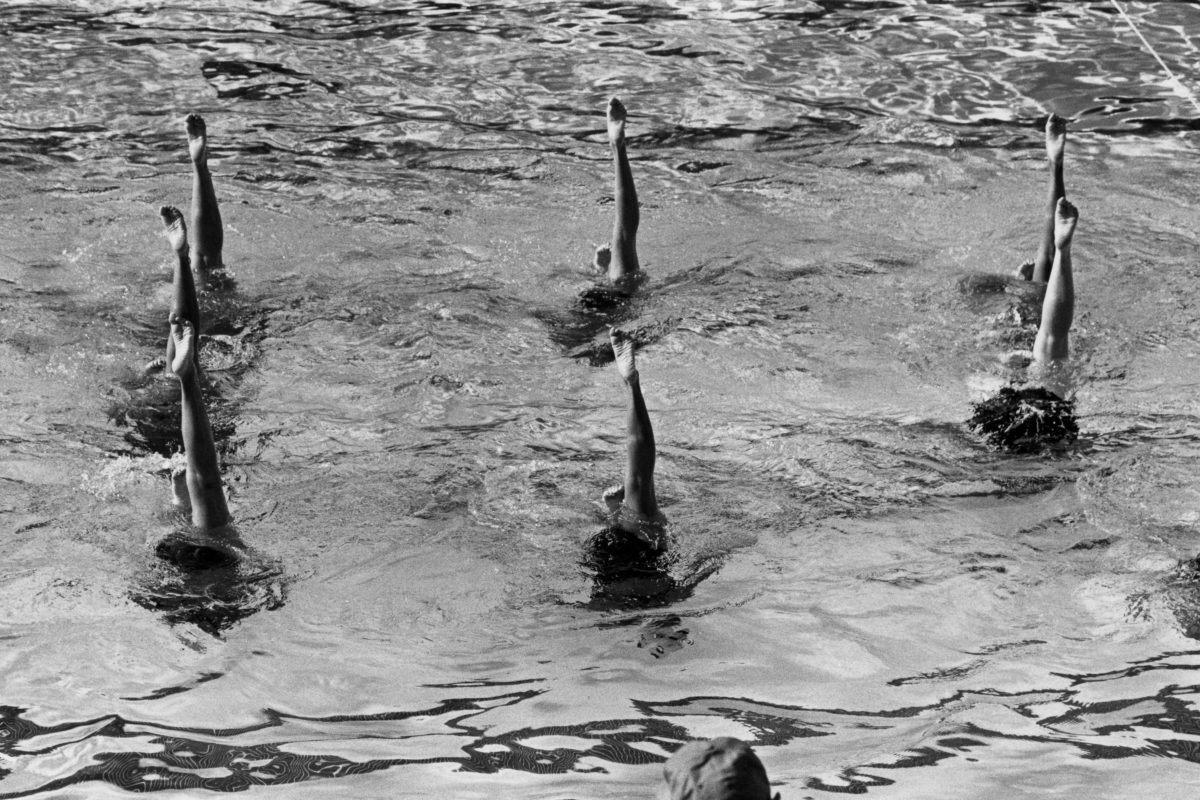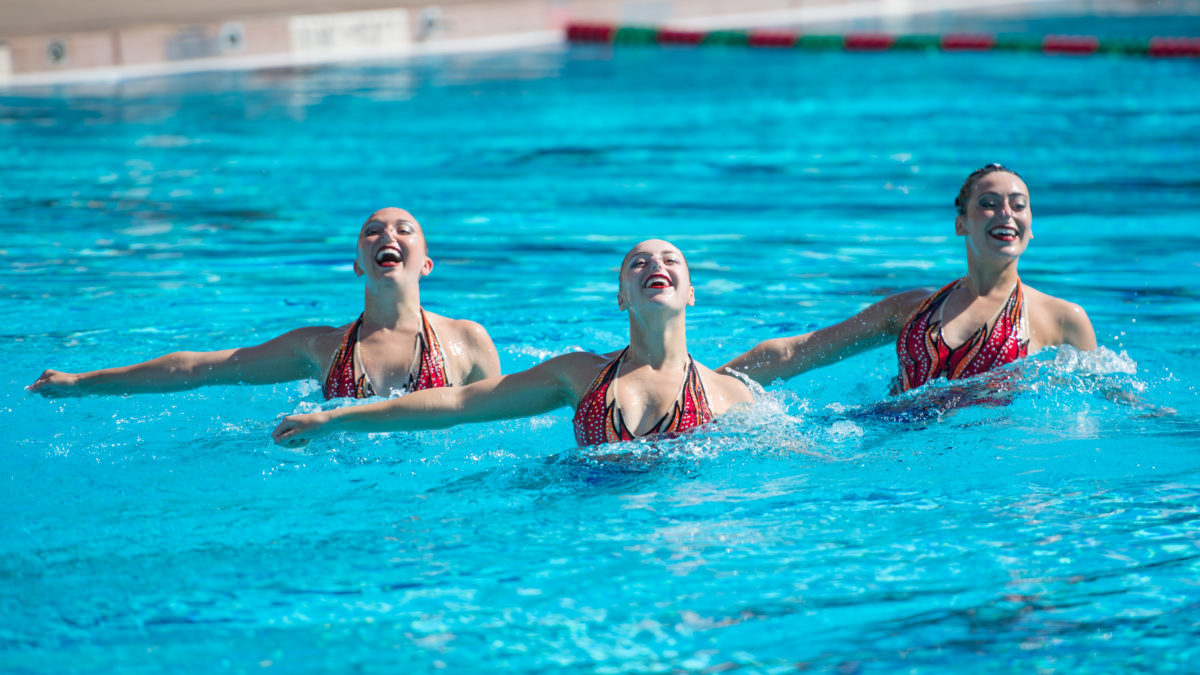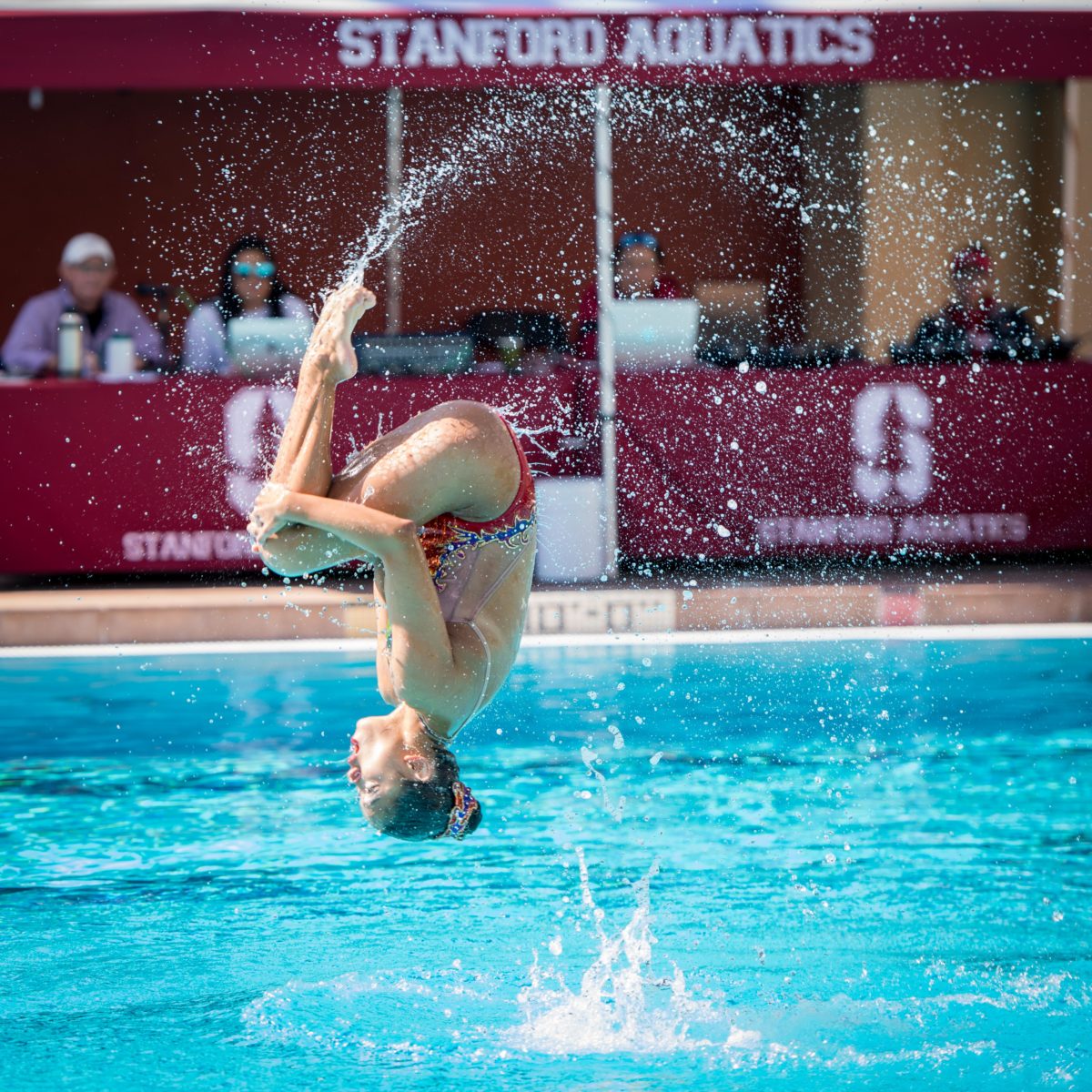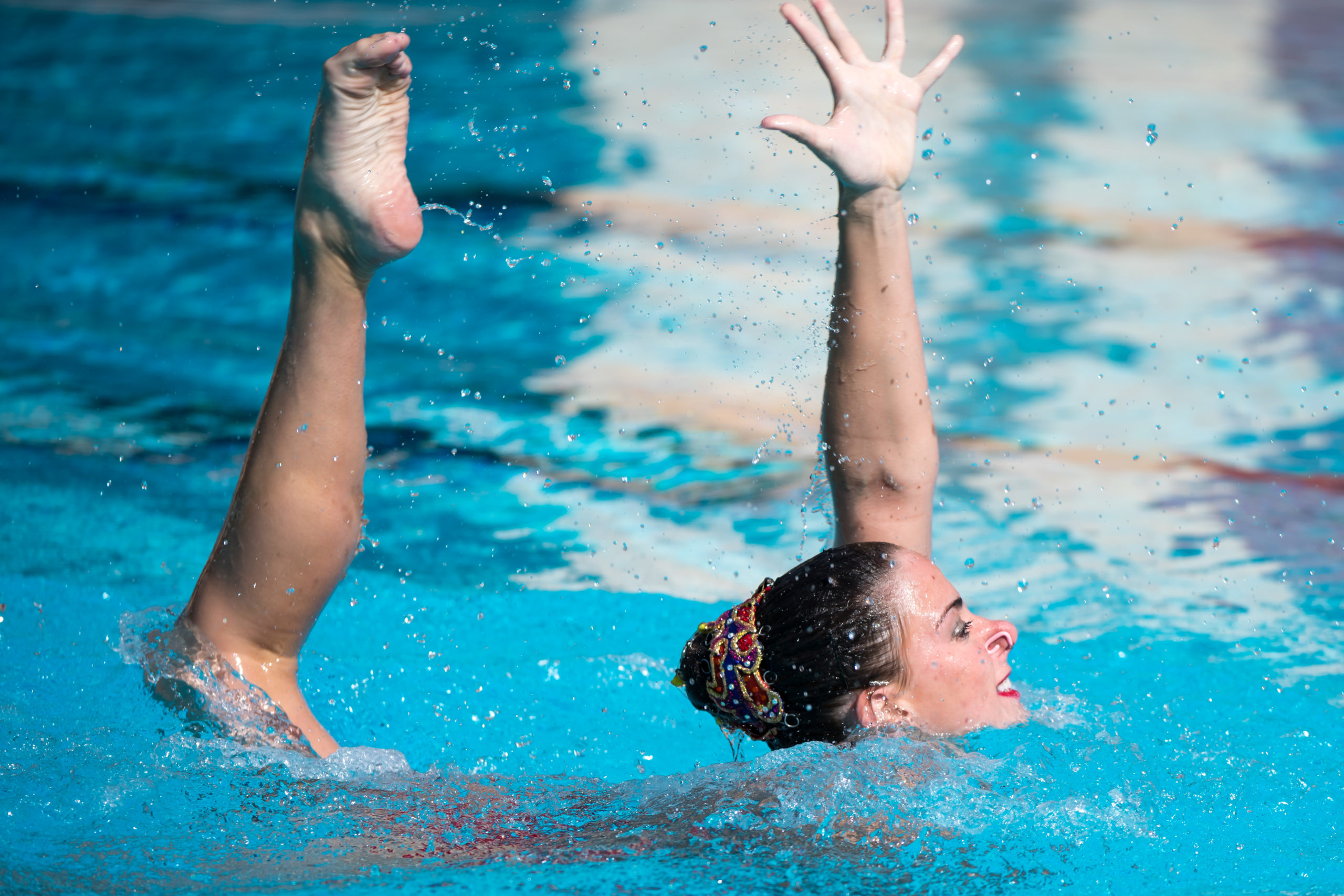“Interrupted Routine” is an article documenting the reactions of Stanford synchronized swimmers, both past and present, to the July 8 announcement that Stanford Athletics would discontinue 11 varsity programs, including the synchronized swimming team, following the 2020-21 season. Stanford Athletics declined to comment and is “not coordinating interviews with coaches or student-athletes at this time.“
Synchronized swimming, also known as artistic swimming, requires perfect team harmony. In each of the four types of routines at collegiate meets — solos, duets, trios and teams — the key is choreography in sync with music, which plays throughout each performance as the swimmers slice through the water.
“We always try to make [the music] both pleasing to us, our team, our athletes and our supporters. We also consider what we think that the officials or the judges are going to enjoy,” said head coach Megan Azebu in January. This music can span across all genres.
Training to perfect each routine requires months of preparation and builds throughout the year, crescendoing at the Collegiate National Championships every March. Often, Stanford synchro swims no more than half of its routine at the first few meets, but adds on to the original routine piece by piece as the season progresses so that the performance at the national meet is the longest and most complex.
But the team’s progress came to a halt earlier this month with Stanford’s announcement that synchronized swimming would be one of 11 sports cut the following year.
Among the reasons cited was “prospects for future success.” But since Azebu joined Stanford in 2012, the team placed in the top-two in the nation for five of eight years. It is consistently one of the winningest programs on the Farm, year after year.
In total, the program has won eight U.S. Collegiate National Championships, two of which came under Azebu’s leadership (2013, 2016).
Another reason for Stanford’s cancellation was that synchronized swimming is not an NCAA sport, but is instead governed by United States Synchronized Swimming (USSS).
Stanford also cited a lack of other Division 1 programs. Stanford competes against three other schools — Ohio State University, University of the Incarnate Word and Wheaton College — to be the U.S. Collegiate National Champion. A fifth school, Texas Woman’s University, recently announced the creation of their own varsity program, set to compete in the fall of 2021. 19 colleges currently have the sport in club form.
Following three straight second place finishes from 2017-2019, the team had a single goal entering the 2019-20 season, according to Azebu: “going after that national championship.” Prior to the cancellation of collegiate sports due to the COVID-19 pandemic, the Cardinal had clinched a spot at the 2020 Collegiate Nationals and was on track to make another title-run.
But for the student-athletes, the sport is about much more than just winning.

The 2020 synchro roster was composed of 13 athletes, who on average spent at least four to five hours a day practicing together. In season, the athletes woke up at 5:15 a.m. for 5:45 a.m. practices which often lasted until 9:00 a.m during the week. Most later returned for another hour and a half in the afternoons for additional work.
“The program itself completely shaped my undergrad career,” said Joanna Langner ’19. “It created the most amazing, resilient, strong, supportive women — an entire community of women like that around me. And to have that support was absolutely amazing… I would say Stanford synchro has been one of the greatest things that I did at Stanford, and I absolutely loved it. It was an amazing program.”
In a sport predicated on coordinated movements and collective actions from the entire team, it’s unsurprising that the synchronized swimming community, both past and present, has come together for a unified stand to save their program.
Synchro alum Mariya Koroleva ’13 started a petition that has more than 4,000 signatures and 100 comments asking the University to reverse the decision on the program.
“I’m willing to raise my hand and stand up and fight for something, anything, any type of change,” said Koroleva, a two-time Team USA Olympian.
A way forward
To many Stanford synchronized swimmers, the most shocking part about Stanford’s cancellation announcement was the delivery of the news. Like those on the other 10 affected sports, the student-athletes only had 30 minute notice of the Zoom webinar announcement, which students-athletes did not know the content of until opening the meeting link. The call lasted only five minutes and did not have time for questions. The rushed delivery and lack of discussion within the meeting made many student athletes and alumni wonder whether cancellation was really the only option.
Upon reading the open letter from the University, Koroleva felt confused by how final the University’s decision seemed.
“If the synchro team said ‘We want to raise an operational budget,’ why can that not be considered?” she said.
“This decision and the way they went about telling us shows that they don’t care about students,” a current synchronized swimmer, who wished to remain anonymous due to fear of repercussions, said. “The University only cares about the finances.”
Going forward, these athletes and alumni believe Stanford could better serve its student-athlete community. In particular, both Li and Koroleva want Stanford Athletics to be more transparent about their decisions and their finances, have a greater deal of communication with current athletes and show athletes more respect.
“I want them to look at their priorities and reevaluate how they’ve been doing things,” Koroleva said. “I want them to hear these voices from alums and current athletes, coaches, supporters.”

“Something that was emphasized to me was that Stanford likes to take care of its athletes because they expect so much out of us. They expect us to be excellent students as well as excellent athletes,” Li said. “And, I just think that if Stanford is going to uphold us to these standards, then Stanford Athletics should also hold themselves up to those standards.”
By the numbers
The University’s open letter announcing the intended cancellations stated that “the decision to discontinue these 11 varsity sports programs comes down primarily to finances and competitive excellence.”
However, diving into the numbers of the sport tells a different story for Stanford’s synchronized swimming program.
According to data from the U.S. Department of Education, the game-day operating expenses per swimmer is $4,702. With 13 swimmers on the roster for the 2019-2020 season, this would put the total game-day operating expenses at $61,126. For context, the cost for a single undergraduate student to attend Stanford University is $78,218.
Because it is not an NCAA sport, Stanford’s synchronized swimming program does not provide athletic scholarships to athletes, which cuts down program costs significantly.
The team carries just one head coach and one assistant, Azebu and Elvira Khasianova, also significantly lowering the overall salary expenses.
According to Koroleva, during her time as an undergraduate, the University cut the assistant coach position due to budget cuts, but the team was able to raise enough money from outside donors to reinstate the position and further decrease the financial burden on the athletics department.
Since then, cutting the program always remained an outside possibility, but it “seemed like things were going OK,” she said.
Despite the financial turmoil at times behind the scenes, the Cardinal flourished in the pool.
“The synchro team at Stanford is one of the best in the nation: we’ve had countless Olympians, national champions, national team members on our team,” the same anonymous synchronized swimmer said. “To completely eliminate our sport barely cuts into the deficit that [Stanford is] trying to reduce.”
A glimpse into the past (and future)
When Karen Li ’20 was in sixth grade, she wrote a letter to her 10-years-in-the-future self.
“I actually got that letter this year — it was mailed to me by my teacher,” Li said. “In that letter, I had written ‘I hope that I am swimming for Stanford.’ That has always been my goal, not to just attend Stanford but to compete for Stanford and be a part of the team.”
Now, looking back on her time with the team, Li has no regrets.
“[Stanford synchro] has really made me kind of appreciate why I started swimming, why I fell in love with swimming,” she said. “It ultimately was a really great way to end my career, loving this sport as much as I started. Personally, being on the synchro team has introduced me to the best teammates and support system that I could ever ask for. The girls that I swim with are the best people I know.”
Much like Li, Langner knew from a young age she wanted to be a Stanford synchronized swimmer. Age seven, to be exact.
“That’s what pushed me in my athletic career,” she said “That’s what pushed me academically.”
Koroleva, who now coaches part-time at her former youth synchronized swimming club along with her full-time job, sees similar passion from the young swimmers she works with. She often sees girls wearing Stanford synchro sweatshirts to practices at the pool; but now, to her, the knowledge that the opportunity to be a Cardinal swimmer is now no longer an option is “gut-wrenching.”
“Literally just last week, one of the girls I coach asked me to write her letter of recommendation for when she applies for [Stanford] next year,” she said, but “knowing that they’re not gonna have that opportunity is … awful. I hate thinking about that.”
As Koroleva notes, the University’s intended cut may change the sport collegiately and may force many future swimmers into difficult decisions.
“Without Stanford synchro being present in the collegiate world is… I don’t even have the words to describe it,” Li said. “I think we will lose out on many young swimmers, who hope to maybe swim collegiately or who hope to train to go to the Olympics.”
“I wanted to go to a school that would allow me to still continue training at a high level and also get the best education possible,” Koroleva said. “I’m an immigrant from Russia, and for my family, education is always number one. My parents always said you could do synchro for as long as you want, but you need to have a good education. So that was kind of number one, but I still had this dream of going to the Olympics.”
Now having represented Team USA at both the 2012 and 2016 Olympics, it’s safe to say her time as a Cardinal was the best of both worlds.
“I know that I would not be the person I am today without that program. That team, even though the team changed year after year, those girls, I still consider to be some of my best friends.”
More than a price tag
One of Li’s fondest memories of the Stanford synchronized swimming team was when she was a freshman swimmer on Stanford’s B-team — the University used to have an A- and B-team — and was suddenly moved up to the A-team due to an injury days before a meet. Even though the task of learning a new routine within a matter of days was daunting, she said that the support that her teammates showed her was well beyond the call of duty.
“I will just never forget the support that the team gave me,” she said. “People offered to stay after practice, to come before practice — and we had 6 a.m. practice, so that’s very early — to help me through whatever I needed. This wasn’t just to do with learning the routine. People were supporting me outside, offering to study with me, just so that I would have someone motivating me because they knew that I was going through such a hard time in the pool.”
To all athletes interviewed, Stanford without synchro would have been extremely different.

During Langner’s time as an undergrad, for example, she was a member of Cardinal RHED, which stands for Resilience, Health and Emotional Development. The group is composed entirely of student-athletes and works to destigmatize athletes’ mental health and well being. Without synchronized swimming, Langner would have never had the opportunity to be a part of this group.
And, to Koroleva specifically, without Stanford synchro being an option, she doesn’t think she would have even applied.
“As great as Stanford is academically, that synchro component was too important for me,” she said. “If that program wasn’t there, my life would have turned out very, very differently.”
To most Cardinal athletes, as Li put it, “there’s so much more to Stanford Athletics than a price tag.”
“Although synchronized swimming is not the most well known sport — it does not bring in the most money, and it might not be the most popular sport — I think that everyone who is a synchronized swimmer, knows a synchronized swimmer or has been to one of our meets, appreciates how difficult it is, both physically and mentally,” she said. “[They] understand that we are pushing the limits of the sport, both physically and creatively.”
Contact Jeremy Rubin at jjmrubin ‘at’ stanford.edu and Shoaib Jamil at sjamil ‘at’ student.norman.k12.ok.us.
